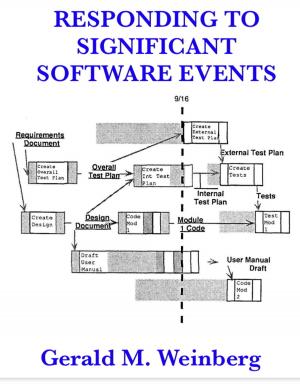Passive Regulation: General Systems Design Principles
Nonfiction, Computers, Networking & Communications, Computer Security, Operating Systems, Application Software| Author: | Gerald M. Weinberg | ISBN: | 9781458094780 |
| Publisher: | Gerald M. Weinberg | Publication: | June 3, 2011 |
| Imprint: | Smashwords Edition | Language: | English |
| Author: | Gerald M. Weinberg |
| ISBN: | 9781458094780 |
| Publisher: | Gerald M. Weinberg |
| Publication: | June 3, 2011 |
| Imprint: | Smashwords Edition |
| Language: | English |
Passive Regulation is Volume 2 in the General Systems Thinking series that begins with the world-wide best-selling, An Introduction to General Systems Thinking. (also available in ebook formats) That first series volume focused on the question,"Why do we see what we see?" This second books tackles the next question, namely "Why do things stay the same?"
Most people take for granted the stability they see in the world, but for systems thinkers, stability is one of the most fundamental properties, and puzzles, about the systems they struggle to understand and create. Indeed, it's such a fundamental property that it forms the topic of both this volume and its successor, Active Regulation (Volume 3 in the series).
Originally part of the book, On the Design of Stable Systems, in its first, hardcover incarnation, Passive Regulation does not just focus on computer systems, but systems of all kinds—human, natural, and technological.
In a highly readable, original presentation the Weinbergs here explore the subtle art and science of regulating systems, projects, and people in the most efficient and logical manner possible. The authors draw on their respective backgrounds in technology and social science to offer fresh insights and translate them into a language that anyone can understand.
In the course of this presentation, and with the help of dozens of figures, the Weinbergs introduce a host of laws and theorems derived from the best thinking of systems thinkers over the past century. For the most part, the regulation schemes examined in this volume are based on redundancy—the simplest, yet in many ways the most subtle, of all regulation strategies.
Chapters include:
The Problem of Persistence
Aggregates
Birth-Free Aggregates
Reasoning About Aggregates
Modeling Differentiated Aggregates
Programs for Models of Differentiated Aggregates
Structure and Behavior of Aggregates
The Structure-Regulation Law
The book also contains an extensive bibliography and an appendix explaining some useful mathematical notation.
In addition to being a reference book for professional and lay people alike, Passive Regulation is suitable as an undergraduate text in the humanities, social, natural, and engineering sciences. It is unique in its approach, highly readable, and offers practical ways of solving problems.
The Library and Information Science Annual said of Passive Regulation: "The authors combine the views of their disciplines and look at larger issues such as the interplay between systems and people, the abstract and concrete, and the theoretical and practical . The authors' style is light and sometimes humorous with a large number of quotations from literature. . . . Never dull . . . the book bears evidence of a global view in which systems design is a means if organizing ideas, structures, things, and experience."
Passive Regulation is Volume 2 in the General Systems Thinking series that begins with the world-wide best-selling, An Introduction to General Systems Thinking. (also available in ebook formats) That first series volume focused on the question,"Why do we see what we see?" This second books tackles the next question, namely "Why do things stay the same?"
Most people take for granted the stability they see in the world, but for systems thinkers, stability is one of the most fundamental properties, and puzzles, about the systems they struggle to understand and create. Indeed, it's such a fundamental property that it forms the topic of both this volume and its successor, Active Regulation (Volume 3 in the series).
Originally part of the book, On the Design of Stable Systems, in its first, hardcover incarnation, Passive Regulation does not just focus on computer systems, but systems of all kinds—human, natural, and technological.
In a highly readable, original presentation the Weinbergs here explore the subtle art and science of regulating systems, projects, and people in the most efficient and logical manner possible. The authors draw on their respective backgrounds in technology and social science to offer fresh insights and translate them into a language that anyone can understand.
In the course of this presentation, and with the help of dozens of figures, the Weinbergs introduce a host of laws and theorems derived from the best thinking of systems thinkers over the past century. For the most part, the regulation schemes examined in this volume are based on redundancy—the simplest, yet in many ways the most subtle, of all regulation strategies.
Chapters include:
The Problem of Persistence
Aggregates
Birth-Free Aggregates
Reasoning About Aggregates
Modeling Differentiated Aggregates
Programs for Models of Differentiated Aggregates
Structure and Behavior of Aggregates
The Structure-Regulation Law
The book also contains an extensive bibliography and an appendix explaining some useful mathematical notation.
In addition to being a reference book for professional and lay people alike, Passive Regulation is suitable as an undergraduate text in the humanities, social, natural, and engineering sciences. It is unique in its approach, highly readable, and offers practical ways of solving problems.
The Library and Information Science Annual said of Passive Regulation: "The authors combine the views of their disciplines and look at larger issues such as the interplay between systems and people, the abstract and concrete, and the theoretical and practical . The authors' style is light and sometimes humorous with a large number of quotations from literature. . . . Never dull . . . the book bears evidence of a global view in which systems design is a means if organizing ideas, structures, things, and experience."















